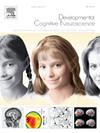Dev-Atlas: A reference atlas of functional brain networks for typically developing adolescents
IF 4.9
2区 医学
Q1 NEUROSCIENCES
引用次数: 0
Abstract
It is well accepted that the brain is functionally organized into multiple networks and extensive literature has demonstrated that the organization of these networks shows major changes during adolescence. Yet, there is limited option for a reference functional brain atlas derived from typically-developing adolescents, which is problematic as the reliable identification of functional brain networks crucially depends on the use of such reference functional atlases. In this context, we utilized resting-state functional MRI data from 1391 typically-developing youth aged 8–17 years to create an adolescent-specific reference atlas of functional brain networks. We further investigated the impact of age and sex on these networks. Using a multiscale individual component clustering algorithm, we identified 24 reliable functional brain networks, classified within six domains: Default-Mode (5 networks), Control (4 networks), Salience (3 networks), Attention (4 networks), Somatomotor (5 networks), and Visual (3 networks). We identified reliable and large effects of age on the spatial topography of these majority of networks, as well as on the functional network connectivity. Sex effects were not as widespread. We created a novel brain atlas, named Dev-Atlas, focused on a typically-developing sample, with the hope that this atlas can be used in future developmental neuroscience studies.
发育图集:典型发育青少年的脑功能网络参考图集
人们普遍认为,大脑在功能上被组织成多个网络,大量文献表明,这些网络的组织在青春期表现出重大变化。然而,对典型发育青少年的参考功能脑图谱的选择有限,这是有问题的,因为功能脑网络的可靠识别关键取决于这些参考功能地图集的使用。在此背景下,我们利用来自1391名8-17岁典型发育青少年的静息状态功能MRI数据来创建一个青少年特异性的功能性脑网络参考图谱。我们进一步调查了年龄和性别对这些网络的影响。使用多尺度个体成分聚类算法,我们确定了24个可靠的大脑功能网络,分为六个领域:默认模式(5个网络)、控制(4个网络)、显著性(3个网络)、注意力(4个网络)、躯体运动(5个网络)和视觉(3个网络)。我们确定了年龄对这些大多数网络的空间地形以及功能网络连通性的可靠和巨大影响。性别的影响没有那么普遍。我们创建了一个新的大脑图谱,命名为Dev-Atlas,专注于一个典型的发育样本,希望这个图谱可以用于未来的发育神经科学研究。
本文章由计算机程序翻译,如有差异,请以英文原文为准。
求助全文
约1分钟内获得全文
求助全文
来源期刊

Developmental Cognitive Neuroscience
NEUROSCIENCES-
CiteScore
7.60
自引率
10.60%
发文量
124
审稿时长
6-12 weeks
期刊介绍:
The journal publishes theoretical and research papers on cognitive brain development, from infancy through childhood and adolescence and into adulthood. It covers neurocognitive development and neurocognitive processing in both typical and atypical development, including social and affective aspects. Appropriate methodologies for the journal include, but are not limited to, functional neuroimaging (fMRI and MEG), electrophysiology (EEG and ERP), NIRS and transcranial magnetic stimulation, as well as other basic neuroscience approaches using cellular and animal models that directly address cognitive brain development, patient studies, case studies, post-mortem studies and pharmacological studies.
 求助内容:
求助内容: 应助结果提醒方式:
应助结果提醒方式:


